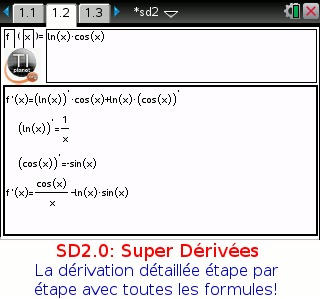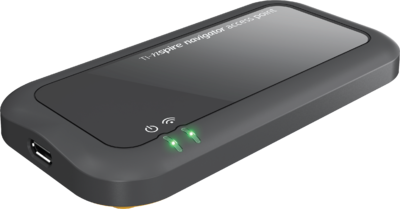Le premier né fut en effet SD2 qui donne toutes les étapes pour les dérivations.


Depuis, j'ai vu passer quelques programmes tentant de suivre mes pas en effectuant des raisonnements par étapes, et suis donc fier d'avoir une fois de plus lancé une mode.

Toutefois, je n'en ai vu aucun exploitant l'affichage en écriture naturel, et SD2 reste à ce jour le meilleur programme de ce type au monde sur calculatrice!

J'ai également vu passer un programme par étapes pour les intégrations par parties.
Et justement cela me rappelle que depuis l'été 2012, SD2 a un petit frère qu'il vous avait caché, SIPP qui s'occupe des intégrations par parties.
Là encore, mêmes avantages avec la saisie intuitive et la réponse détaillée prête à être recopiée en écriture naturelle.


SIPP s'adapte automatiquement à certains cas particuliers (u'v=kuv'), et au delà d'une simple intégrale permet de déterminer une primitive, ce qui à ma connaissance est novateur sur calculatrice!

Mais SIPP innove aussi sur un autre domaine, puisqu'il analyse l'expression saisie et détermine automatiquement quels facteurs sont utilisables pour effectuer une intégration par parties! Vous n'avez plus qu'à choisir parmi ceux qui restent dans une simple liste déroulante!

Pourquoi n'avais-je donc pas publié ce petit bijou depuis tout ce temps?
Tout simplement car depuis la rentrée 2012 l'intégration par parties n'est plus au programme de Terminale, ce que certains semblaient effectivement encore ignorer.
Je le publie donc aujourd'hui à destination des étudiants de l'enseignement supérieur scientifique (même si je doute que l'intégration par parties soit leur principale préoccupation), mais également pour les élèves d'autres pays que la France qui n'auraient pas encore banni l'intégration par parties de leur enseignement secondaire.
Effectivement, je n'utilise aucun mot de français dans le programme et uniquement des notations mathématiques internationales!

Pour les utilisateurs éventuels, peu nombreux je le crains, n'hésitez pas d'autant plus à remonter tout bug ou problème afin de parfaire ce programme si besoin est - car si vous ne le faites pas, personne d'autre ne le fera.
TI-Planet, le site qui publie de vrais programmes!
Liens:
SIPP: Super Intégration Par Parties par étapes
SD2: Super Dérivées par étapes
(nécessitent une TI-Nspire CAS munie d'un OS 3.2 ou ultérieur)


























